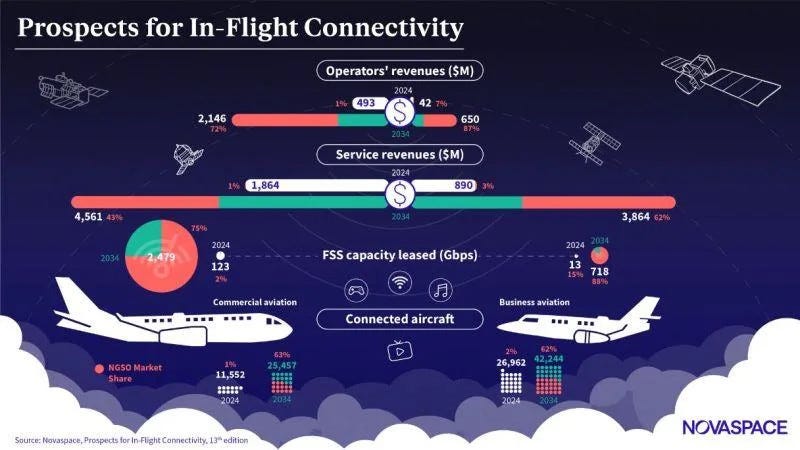NGSO Set to Disrupt In-Flight Connectivity Landscape
Incoming Non-Geostationary Orbit Services Shift Sector Norms
The 13th edition of the Novaspace "Prospects for In-Flight Connectivity Report" finds NGSO (Non-Geostationary Orbit) services are poised to revolutionize in-flight connectivity standards. NGSO’s share of commercial aviation IFC is set to skyrocket from just 1% in 2024 to 63% by 2034, driving 76% of total operator revenues by decade’s end.
"Starting in 2025, we expect NGSO networks to begin replacing older GEO Ku/Ka-band and ATG (Air-to-Ground) systems at scale.”
Vishal Patil, Novaspace
As NGSO networks enter the IFC market in full force, competition is expected to intensify, driving aircraft ARPA stabilization. However, with the drop in capacity pricing increasing pressure on service providers, the market is positioned for further vertical integration via mergers and acquisitions.
“2024 was a transitional year,” says Vishal Patil, Project Manager at Novaspace. “While most installations still relied on GEO-based systems due to legacy contracts, the momentum is clearly shifting. Starting in 2025, we expect NGSO networks to begin replacing older GEO Ku/Ka-band and ATG systems at scale.”
Major strategic moves are already underway to capitalize on the NGSO trend. High-profile partnerships such as the SES-Intelsat merger and the Intelsat-Eutelsat-OneWeb alliance are paving the way for multi-orbit service offerings. These hybrid models aim to combine the reliability of GEO and its ability to densify supply over high-demand areas, with the performance advantages of LEO, offering a best-of-both-worlds solution.
Business and General Aviation operators and commercial airlines are increasingly opting for these multi-orbit models, though the rollout remains constrained by equipment readiness. Many terminals are still in early development stages and yet to be flight-proven at scale, presenting a temporary bottleneck in widespread adoption.
Overall, the number of connected aircraft is set to exceed 67,700 by 2034. Airlines are now actively assessing ways to monetize this IFC revolution as players increasingly move towards providing either full or partially free IFC services. As the market enters this new phase, NGSO adoption will redefine connectivity standards in aviation. To remain competitive, players must adapt quickly with a focus on hardware innovation, strategic alliances, and service differentiation.



